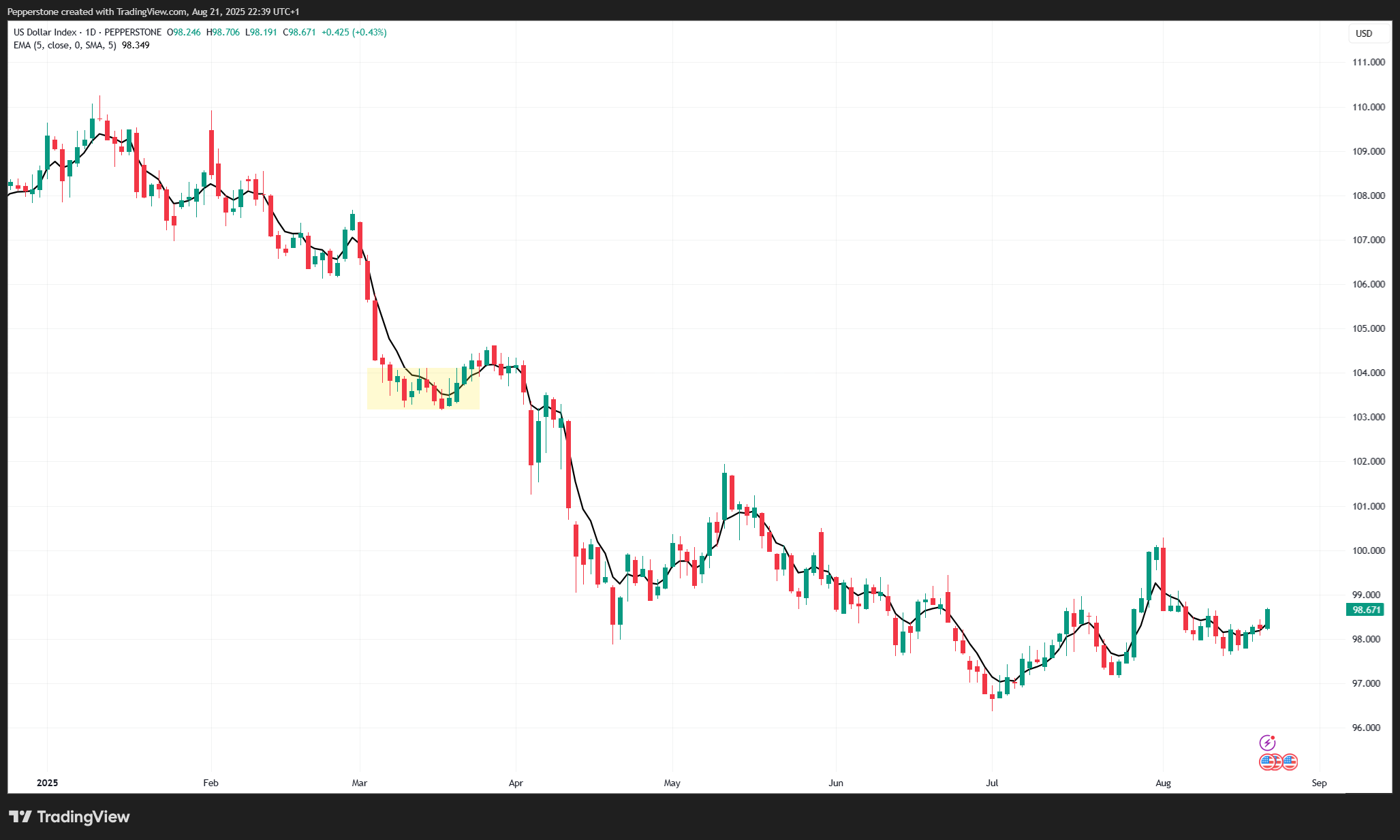CFDs are complex instruments and come with a high risk of losing money rapidly due to leverage. 72.2% of retail investor accounts lose money when trading CFDs with this provider. You should consider whether you understand how CFDs work and whether you can afford to take the high risk of losing your money.
- English
- Italiano
- Español
- Français
Powell’s Jackson Hole Speech in Focus as Fed Credibility Faces Test

The market has pre-positioned portfolios for the risk from Fed Chair Jay Powell’s speech at Jackson Hole (10am ET). While the forward volatility markets are not pricing any significant lift in cross-asset vol – with Nvidia’s earnings day (Wednesday, after market) still implied to generate the more explosive move – Powell’s speech is considered critical for pricing risk into the September, and even October and December, FOMC meetings.
Much ink has been spilled on what Powell may say, how he guides market expectations, and whether he skews the Fed’s reaction function towards the labour market and growth focus of the dual mandate or maintains a heavier weighting on inflation.
Powell to guide on the Fed's reaction function - Max optionality the play
At the heart of the debate, the Fed has maintained that current policy is moderately restrictive and should only change if there are real concerns about the labour market. Yet, despite three-month average in payrolls growth now at just 35k and the sizeable, consistent downward revisions, Fed voters – particularly those more concerned with core PCE moving further away from its 2% target – will want to see another poor NFP print on 5 September before supporting an insurance cut.
With the 2021 ‘transitory’ fiasco still fresh in many bond traders’ minds, the Fed’s credibility is firmly in focus. Cutting rates in September with core PCE set to push 100bp+ above target would be a tough call in any environment. The Fed’s more hawkish members will worry that even if August NFP proves weak, there is always the risk of a rebound – and the word resilience returning to the fore. A move to a neutral policy rate with core PCE heading towards 3.2%+ in Q4, alongside a possible rebound in jobs, fiscal expansion, and Trump doing all he can to juice up the economy ahead of the November 2026 Mid-term elections, could see the bond market send a strong message of discontent, driving long-end yields higher and seeing foreign investors pull back on USD-denominated assets (ex-gold).
What’s more, our ability to price inflation risk remains a real challenge. We don’t yet know if tariff pass-through will be gradual – a phased approach that takes time to filter into prices – or a series of step-ups in the price level. Walmart’s CFO noted in its earnings call that “tariffs have started to materialise in higher prices, which would become more significant later in the year” – a clear anecdotal signal to where the risk for inflation resides.
The Fed's credibility at stake, yet again
In essence, the Fed is in a bind, at the mercy of data that may prove inaccurate or subject to sharp trend reversals in the coming months. The prospect of cutting in September only for hindsight to show it was a mistake is elevated. With three – possibly four – Fed governors already seen as Trump’s puppets, it is hard not to conclude that the Fed’s credibility is at risk of being burnt. In some ways, it already is, though few are currently expressing this in capital markets.
All roads therefore lead to Powell pushing for full optionality in September, offering a more dynamic stance where the incoming NFP and core CPI prints will determine which side of the dual mandate requires priority. One thing seems assured: unless Powell explicitly calls for a September cut – a very low probability – Trump will be quick to take to Truth Social to make his feelings known.
Positioning driving the moves in markets on the day
For now, market players continue to adjust portfolio exposures accordingly. US interest-rate swap traders have trimmed the implied pricing for a September Fed cut to 73%. US Treasury yields lifted 4bp across the curve – driven partly by CTAs who remain heavily long Treasury futures, as well as by a hotter S&P Global PMI report and hawkish commentary from Fed members Hammack and Schmid. The USD moving higher in sympathy with UST yields, where shorts have cut back, and this helped fuel net selling in gold. In equity, traders have pared core long positions, rotated into value, and shown some appetite for buying volatility as a hedge against further drawdown.

Asia offering a safe place for traders
The leads from Wall Street were hardly emphatic, so Asia – notably the ASX200 and HK/China – should act as a safe harbour while the Fed’s credibility is under the spotlight. Calls for the open suggest some green on screen for equities, but hesitation to push risk higher will remain. While volatility markets frame Jackson Hole as a “Fed meeting lite”, there is always the risk that vol has been mis-priced – and things could get a little spicy, especially as we roll towards month-end and the US Labor Day holiday.
Good luck to all.
The material provided here has not been prepared in accordance with legal requirements designed to promote the independence of investment research and as such is considered to be a marketing communication. Whilst it is not subject to any prohibition on dealing ahead of the dissemination of investment research we will not seek to take any advantage before providing it to our clients.
Pepperstone doesn’t represent that the material provided here is accurate, current or complete, and therefore shouldn’t be relied upon as such. The information, whether from a third party or not, isn’t to be considered as a recommendation; or an offer to buy or sell; or the solicitation of an offer to buy or sell any security, financial product or instrument; or to participate in any particular trading strategy. It does not take into account readers’ financial situation or investment objectives. We advise any readers of this content to seek their own advice. Without the approval of Pepperstone, reproduction or redistribution of this information isn’t permitted.